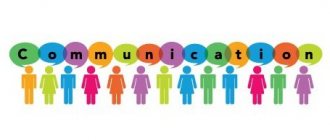Communication and communication are integral parts of human nature. The differences between the terms can be fully understood by providing definitions for each. A person must communicate for harmonious development, but communication allows him to learn more while in society. Concepts are perceived differently by specialists in the field of psychology and philosophy. Creative individuals also have their own views on them. That is why it is important to know what differences there are and whether they exist regarding these terms.
The communicative side of communication
You might be interested in: What kind of method is functionalism? Concept, theory, concept and principles of functionalism in sociology
Communication as communication is the mutual exchange of information between interlocutors, the transmission and reception of knowledge, points of view and feelings. It should be noted that information in the process of communication is not simply transferred from one person to another (the person who transmits information is called the communicator, and the receiving party is called the recipient) - an exchange is carried out. It can be implemented both at the speech (verbal) and non-speech (non-verbal) level.
Basic concepts: briefly
Communication is a complex, multi-level process of social interaction between people and groups .
The information and communication function of communication is to establish mutual understanding and relationships between subjects of joint activities.
The communication process includes a communicative component (exchange of information), interaction (direct activity), perception (perception, cognition of the opponent).
Communication is an active interaction during which information is exchanged.
Its success depends on the extent to which the information transmitted by one interlocutor is reliably and objectively perceived by the second interlocutor .
Verbal information and its transmission
You might be interested: “Old school” is a fashion for the past
Verbal communication (communication) involves the use of human speech as a means of transmitting information. Often in society one may come across the opinion that speech can hide the true essence of a person. On the other hand, it is she who can demonstrate it, without any principles and against the will of the speaker. It is worth noting that verbal communication (verbal communication) plays a vital role in public life. The fact is that the effectiveness of a category is usually associated with the communicative aspect.
The key goal of exchanging information is to develop one point of view between communicating people, to achieve agreement regarding certain problems and situations. In this case, a correct understanding of the information plays a crucial role. That is why the ability to competently express one’s own thoughts, as well as the ability to listen, are integral components of communication as communication.
Definition
Communication in psychology is the conscious or subconscious transmission and exchange of information with other people. It is a unique form of interaction between individuals, which is carried out through cognitive activity. Refers to targeted influence on the values and views of the interlocutor, which are built on the basis of a rational component.
Communication can be considered as a necessary condition for the development of human relationships. The ability to transmit information is also one of the fundamental aspects of improving the entire society, since it acts as the main interaction between different ethnic groups.
The author of the term, a sociologist of the American school of psychology, Charles Coopey at the beginning of the 20th century defined communication as “the mechanism through which absolutely all human relationships exist and develop - in the context of subconscious images, combined with methods of their visualization and transmission in life, including preservation in time."
According to the Soviet scientist I.P. Yakovlev, as well as other psychologists in related topics, the definition of communication should be understood as a system of research practice in the role of communication in society, including: development, structure and content, practical use.
At the same time, M. S. Andrianov localizes the definition as an understanding of the initial aspects of social interaction, starting only from the semantic meaning.
Based on the words of the German sociologist Niklas Luhmann, communication is “a specific historical event that depends on the time stage.”
He also characterized the definition as a set of actions suitable for social systems, the presence of which redistributes knowledge in society. He did not perceive communication in the role of transmitting information or the semantic content of the psychological subsystem.
Communication in psychology is a means by which individuals can maintain and construct their own relationships among themselves, according to T. Sillars and A. Vangelisti,
History of development
Research practice aimed at studying communication as an independent scientific and sociological field is associated with the development of infocommunications based on telecommunications and information technologies.
In particular, the formation of communication was influenced by the emergence of radio in the 1920s. Later, with the advent of computers and television, as well as with the beginning of the globalization of large companies, the process of research as a scientific and psychological phenomenon increased several times.
The first communication department was opened in the early 1940s in the USA. According to the words of Doctor of Philosophy, part-time professor of social philosophy A. V. Nazarchuk, the manifestation of the problematics of the term developed based on 3 main directions:
- Anglo-American. Aimed at analyzing the linguistically determined process, as well as clarifying the linguistic taxonomy of different peoples;
- French. It is distinguished by the unlimited semantic meaning of linguistic communication, which is determined by the social problems of modern society: ideological distortions, a critical mood towards power, lack of comprehension, etc.
- "Philosophy of Dialogue". It is characterized by a polemical attitude towards philosophy of the transcendental and psychological type, starting from the subjectivity of the meaning “I - You” towards communication. Developed by M. Buber, M. Bakhtin, F. Ebner and others.
F.I. Sharikov coined the neologism “communicationology,” which explained any research activities aimed at an objective understanding of communication—systematized knowledge about the development of means of communication as a psychological phenomenon.
In psychology and linguistic practice, communication is considered as factors contributing to the correct perception and transmission of figurative information, which explains the process of local and mass activity. This also made it possible to derive a definition of a communicator—a participant in a dialogue.
What influences understanding of information?
You may be interested in: What is “full”? What meanings does the word hide?
The understanding of messages received by the recipient from the communicator is significantly influenced by their content and form. They primarily depend on the attitude of the speaker to the listener, his personal characteristics, as well as on the specific situation in which the process of communication takes place. For example, your conversation with your best friend will somehow be different from communication with clients or teachers. In addition, communication must take into account certain values of the interlocutor. The point is that in the process of viewing the world through your own “vision”, you should not forget that your partner sees, hears and thinks a little differently. By the way, this is where misunderstandings arise between adults and children. They attach completely different meanings to surrounding circumstances and objects.
The meaning of communication skills
Developed communication skills plus personal experience and knowledge help to cope with many problems that often arise unexpectedly and in situations unusual for us. Here, not only innate communication abilities are important, but also skills developed throughout life.
Moreover, these skills can and should be specially trained in order to expand communicative experience and use existing ones more effectively in certain situations.
Having in stock, developed options and stereotypes of communication, using them creatively in various conditions, you can feel confident and calm (you will also be interested in learning about training to increase self-confidence).
Information Features
Communication and communication technology assumes that the sent message can be changed as a result of the influence of the recipient’s personality characteristics, as well as his attitude towards the speaker, the specific situation and the content of communication. It is worth keeping in mind that any information goes through a kind of “trust-distrust” filter. That is why true information can often seem unpleasant, and false information pleasant. To a greater extent, a person trusts information received from close people, to a lesser extent - from distant acquaintances or strangers. Often, in the process of communication as communication, a person is faced with the fact that his motives and words are incorrectly perceived by the interlocutor, in other words, they “do not reach” him. Indeed, some obstacles and difficulties may arise along the way of transmitting information. In this case we are talking about communication barriers, which are classified into attitudinal barriers, misunderstanding barriers and socio-cultural difference barriers.
Communication and Communication: Differences
Today, communication, being a fairly common concept, is perceived differently by philosophers, psychologists, creative individuals and other people who are not particularly concerned about the content of the category when they are talking on the phone or discussing a particular topic. Many people believe that communication and communication are the same category. Is it really?
Communication should be understood as a multifaceted process of mental, intellectual and speech activity, which is aimed primarily at the formation and further development of contacts. Communication is nothing more than a set of speech and non-speech operations, the result of which is the exchange of information at the level of interpersonal interaction. So, there are still differences in the concepts of “communication” and “communication”.
Comparison of categories
You will be interested in: Development of cognitive abilities of junior schoolchildren, Federal State Educational Standards: formation, foundations of education, goals and objectives
The most important property of communication is universality, the ability to competently connect the types of relationships between people that exist today, which serve as a tool to satisfy the need for teamwork and enable each person, through the category of mutual understanding, to consider himself as a unique individual. This primarily includes communication (the type of communication that is considered the main one), interaction between participants in the communication process and their direct perception of each other as partners developing a dialogue.
Communication as a type of communication
Communication, being one of the types of communication, is endowed with the most important functions. This includes a person’s speech activity, tactile and visual ability to perceive information through facial expressions, gestures, intonation and postures. This type of communication, communication, and speech are closely related. The fact is that in the process of communicative communication a person listens and speaks. In addition, he expresses his own attitude towards the interlocutor and the content of the speech. A person can smile or get angry, emphasize the importance of what was said by lightly touching the partner’s hand, or “throw” phrases in an ironic tone. He may lean back a little to demonstrate distrust of the interlocutor's words, or perform a number of other actions. Communication and means of communication complement each other, because verbal contact is now almost impossible without non-verbal information. It should be borne in mind that only in this form does it become the basis of communication.
Communication systems
Communication and all accompanying processes have a close relationship with sign systems. These include numerical symbols, symbols, alphabet, road signs, as well as sound and color signals. It is worth noting that the use of these symbols facilitates the establishment of distance communication if direct contact between the participants is considered impossible.
Communication as communication and a form of interpersonal relationships combines perceptual and interactive functions with communicative ones. If communication is associated with the exchange of information between people, then the perceptual side is responsible for their perception of each other, and the interactive side involves organizing the interaction between them in accordance with the type of business, personal or official communication.
Basic communication model
The specifics of information exchange traditionally depend on the characteristics of society, which determines the content of a wide range of sociocultural meanings in this concept. But in any case, the term “communication” is characterized by the presence of five components necessary for a successful interaction process:
- source (one who wants to convey his thought to another person) - essentially this is the addresser, acting as a generator of a message for transmission;
- a conductor or converter (that which converts a message into signals) - that is, a regular transmitter sending messages through any communication channel;
- direct communication channel (means, path for transmitting information);
- receiver (that which adapts and deciphers the source signal) is the same as the decoder, which translates the signals into a “digestible” message;
- recipient (the one to whom the information should have reached) - the final addressee for whom the message was intended.
According to this model of a communication act, the addresser generates and encodes certain information using sign means used in the sign system of the corresponding communication channel.
The recipient, in order to assimilate the information received, does the same thing, only in reverse order (the result of his efforts is decoding).
Test of ability to work in a team. Questionnaires for personnel officers.
Nonverbal communication. Optical-kinetic sign system
As it turned out, the exchange of information is carried out not only through speech, but also through other sign systems, which together form the means of non-verbal communication. First, let's consider the optical-kinetic system, which involves the use of pantomime, gestures and facial expressions. It is worth noting that in classical literature you can find more than 20,000 characteristics of facial expression. For example, L.N. Tolstoy in the famous novel “War and Peace” displayed 93 different descriptions of a smile.
When trying to create an internal classification of the optical-kinetic sign system, it turned out that it was relevant to use a principle similar to the general one. Thus, the face is divided into three parts using horizontal lines: forehead and eyes, nose and nasal area, chin and mouth. The following are 6 key emotions that are most often used through facial expressions: surprise, fear, sadness, anger, joy and disgust. You should know that setting an emotion in accordance with the “zone” allows you to record facial movements more or less definitely.
Gestures and postures that a person uses when communicating have a fairly serious impact on the interlocutor. For example, defensive gestures (arms crossed on the chest; clenched fists; palms covering the face) suggest an increased sense of closedness in the interlocutor, and accordingly, worsen contact. On the contrary, a smiling face and open palms unconsciously relieve the feeling of tension even in a person with whom you are in a very strained relationship.
Proxemics and eye contact
Proxemics is nothing more than the organization of time and space in the process of communication. Consider, for example, the norms for a person’s approach to an interlocutor, characteristic of American culture (in centimeters):
- From 0 to 45 – intimate distance.
- From 45 to 120 – personal distance.
- From 120 to 400 – social distance.
- From 400 to 750 is the public distance.
Team members should be to the right of the leader.
In addition, each person has his own “personal space zone”, which can be realized intuitively. As a rule, it varies from 40 to 50 centimeters. If this zone is crossed by an unsympathetic or unfamiliar person, spontaneous irritation appears. However, when dealing with attractive people, you should expect the opposite reaction. By changing the physical distance, you can even control the state of your interlocutor. You should know that for women this distance is to some extent greater than for the male part of the population. That is why ladies react more painfully to its reduction.
Visual contact should be understood as the duration of glances, the frequency of their exchange, a change in the dynamics and tactics of glances, or their avoidance. For example, researchers have shown that a woman's pupils dilate when she looks at her loved one. Undoubtedly, this makes her face more attractive compared to her face in a situation where she looks at an unpleasant or unfamiliar person.
Functions and role
Communication in psychology is a definition that indirectly affects the development of social interaction between people.
It is a particularly significant process that has its own goals and functions:
- ensuring productive and high-quality exchange of information;
- development of interpersonal communication based on data exchange;
- creation and improvement of transmission channels;
- regulation and intellectualization of information flows.
- informing, warning and persuading others.
The goals of communication in the context of different groups differ in their functionality. If in emergency situations it is necessary to provide general information to the participants, or to reassure them, then, for example, for educational purposes, to train, support or unite a group of people.
Based on the personalized goals of the subject, in scientific practice the following communication functions are distinguished:
- Informational. Communication acts as a mediator, which is characterized by the exchange of opinions, information, decisions and plans between communicants. Such an exchange develops both in solving problems and for practical purposes, including maintaining relations between subjects.
- Social. Development and formation of cultural components in the relationship of individuals. It is characterized by the formation of personal opinions or worldviews, as well as reactions to certain events. It is characterized by ensuring high competence in a person, with the help of which coexistence within the framework of cultural characteristics is qualitatively improved.
- Expressive. Used to express and understand certain emotional experiences. It consists of direct collection of an informative component and a verbally substantiated assessment model. Explains the theory of liking for specific people. So, if the first impression of the opponent turns out to be bad, further plans for developing the relationship may be ruined. Any expression of emotional manifestations is especially important if you want to improve the dialogue with your interlocutor. Characterized by increased self-expression of emotions or feelings through both types of communication - verbal and non-verbal.
- Pragmatic. It makes it possible to regulate behavioral factors and evaluate the activities of conversation participants, as well as coordinate actions in any direction. It can be used both for yourself and for a partner, which allows you to motivate him to perform certain actions.
- Interpretive. Helps to better understand the interlocutor, his attitudes or intentions, and also to identify unwanted experiences during the conversation. Most often used to collect and communicate information to assist in an activity, assessment, or opinion.
The social-role context of communication is associated with the presence of expectations and cannot manifest itself without knowledge of the environment. The level of business relations is realized through joint cooperation between communication partners.
Personal-intimate character obliges a person to satisfy his own needs for understanding, experiencing or sympathy of another individual. For this, psychological factors such as empathy, intimacy or trust are usually used.










